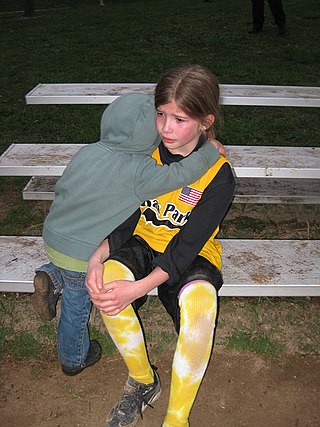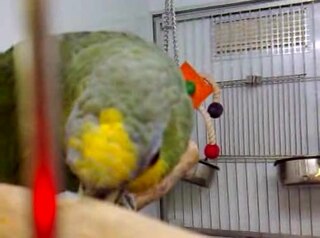
Empathy is generally described as the ability to take on another's perspective, to understand, feel, and possibly share and respond to their experience. There are more definitions of empathy that include but is not limited to social, cognitive, and emotional processes primarily concerned with understanding others. Often times, empathy is considered to be a broad term, and broken down into more specific concepts and types that include cognitive empathy, emotional empathy, somatic empathy, and spiritual empathy.
Sympathy is the perception of, understanding of, and reaction to the distress or need of another life form.
A mirror neuron is a neuron that fires both when an organism acts and when the organism observes the same action performed by another. Thus, the neuron "mirrors" the behavior of the other, as though the observer were itself acting. Mirror neurons are not always physiologically distinct from other types of neurons in the brain; their main differentiating factor is their response patterns. By this definition, such neurons have been directly observed in humans and primate species, and in birds.

The mimic octopus is a species of octopus from the Indo-Pacific region. Like other octopuses, it uses its chromatophores to disguise itself with its background. However, it is noteworthy for being able to impersonate a wide variety of other marine animals. Although many animals mimic either their environment or other animals to avoid predation, the mimic octopus and its close relative the wunderpus are the only ones known to actively imitate several animals in order to elude predators.
Emotional contagion is a form of social contagion that involves the spontaneous spread of emotions and related behaviors. Such emotional convergence can happen from one person to another, or in a larger group. Emotions can be shared across individuals in many ways, both implicitly or explicitly. For instance, conscious reasoning, analysis, and imagination have all been found to contribute to the phenomenon. The behaviour has been found in humans, other primates, dogs, and chickens.

Ant mimicry or myrmecomorphy is mimicry of ants by other organisms; it has evolved over 70 times. Ants are abundant all over the world, and potential predators that rely on vision to identify their prey, such as birds and wasps, normally avoid them, because they are either unpalatable or aggressive. Some arthropods mimic ants to escape predation, while some predators of ants, especially spiders, mimic them anatomically and behaviourally in aggressive mimicry. Ant mimicry has existed almost as long as ants themselves; the earliest ant mimics in the fossil record appear in the mid-Cretaceous alongside the earliest ants.
Empathy-altruism is a form of altruism based on moral emotions or feelings for others.

Talking birds are birds that can mimic the speech of humans. There is debate within the scientific community over whether some talking parrots also have some cognitive understanding of the language. Birds have varying degrees of talking ability: some, like the corvids, are able to mimic only a few words and phrases, while some budgerigars have been observed to have a vocabulary of almost 2,000 words. The hill myna, a common pet, is well known for its talking ability and its relative, the European starling, is also adept at mimicry. Wild cockatoos in Australia have been reported to have learned human speech by cultural transmission from ex-captive birds that have integrated into the flock.

Mirroring is the behavior in which one person subconsciously imitates the gesture, speech pattern, or attitude of another. Mirroring often occurs in social situations, particularly in the company of close friends or family, often going unnoticed by both parties. The concept often affects other individuals' notions about the individual that is exhibiting mirroring behaviors, which can lead to the individual building rapport with others.
The simulation theory of empathy holds that humans anticipate and make sense of the behavior of others by activating mental processes that, if they culminated in action, would produce similar behavior. This includes intentional behavior as well as the expression of emotions. The theory says that children use their own emotions to predict what others will do; we project our own mental states onto others.

Face negotiation theory is a theory conceived by Stella Ting-Toomey in 1985, to understand how people from different cultures manage rapport and disagreements. The theory posited "face", or self-image when communicating with others, as a universal phenomenon that pervades across cultures. In conflicts, one's face is threatened; and thus the person tends to save or restore his or her face. This set of communicative behaviors, according to the theory, is called "facework". Since people frame the situated meaning of "face" and enact "facework" differently from one culture to the next, the theory poses a cross-cultural framework to examine facework negotiation. It is important to note that the definition of face varies depending on the people and their culture and the same can be said for the proficiency of facework. According to Ting-Toomey's theory, most cultural differences can be divided by Eastern and Western cultures, and her theory accounts for these differences.
Empathic concern refers to other-oriented emotions elicited by, and congruent with the perceived welfare of, someone in need. These other-oriented emotions include feelings of tenderness, sympathy, compassion and soft-heartedness.
Interpersonaladaptation theory (IAT) is often referred to as a theory of theories. Several theories have been developed to provide frameworks as explanations of social interactions. After reviewing and examining various communication theories and previous empirical evidence pertaining to interpersonal communication, a need to address ways in which individuals adapt to one another in interactions became apparent. The importance of observing both sides of a dyadic interaction lead to the development of the interpersonal adaptation theory. The theory states, individuals enter interactions with expectations, requirements, and desires, which combined establish an interaction position. Once the interaction begins, the difference between interaction position and the other party's actual behavior determines whether the individual will adapt and continue the communication positively or not.
Limbic resonance is the idea that the capacity for sharing deep emotional states arises from the limbic system of the brain. These states include the dopamine circuit-promoted feelings of empathic harmony, and the norepinephrine circuit-originated emotional states of fear, anxiety and anger.
Relational transgressions occur when people violate implicit or explicit relational rules. These transgressions include a wide variety of behaviors. The boundaries of relational transgressions are permeable. Betrayal for example, is often used as a synonym for a relational transgression. In some instances, betrayal can be defined as a rule violation that is traumatic to a relationship, and in other instances as destructive conflict or reference to infidelity.

Chemical mimicry is a type of biological mimicry involving the use of chemicals to dupe an operator.

In humans, posture can provide a significant amount of important information through nonverbal communication. Psychological studies have also demonstrated the effects of body posture on emotions. This research can be traced back to Charles Darwin's studies of emotion and movement in humans and animals. Currently, many studies have shown that certain patterns of body movements are indicative of specific emotions. Researchers studied sign language and found that even non-sign language users can determine emotions from only hand movements. Another example is the fact that anger is characterized by forward whole body movement. The theories that guide research in this field are the self-validation or perception theory and the embodied emotion theory.
Social cues are verbal or non-verbal signals expressed through the face, body, voice, motion and guide conversations as well as other social interactions by influencing our impressions of and responses to others. These percepts are important communicative tools as they convey important social and contextual information and therefore facilitate social understanding.
Social Mirror Theory (SMT) states that people are not capable of self-reflection without taking into consideration a peer's interpretation of the experience. In other words, people define and resolve their internal musings through other's viewpoint. SMT's background is derived from the 1800s from concepts related to the study of public opinion and social interaction by Wilhelm Dilthey, the German philosopher and sociologist.
Perspective-taking is the act of perceiving a situation or understanding a concept from an alternative point of view, such as that of another individual.








